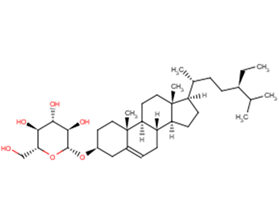
Sitogluside
CAS No. 474-58-8
Sitogluside ( Sitogluside; NSC 165962; Lyoniside, Daucosterol, Eleutheroside A )
Catalog No. M18590 CAS No. 474-58-8
Eleutheroside A (Daucosterol) has proliferation-enhancing activity, may be involved in the IGF1-AKT pathway.
Purity : 98%
 COA
COA
 Datasheet
Datasheet
 HNMR
HNMR
 HPLC
HPLC
 MSDS
MSDS
 Handing Instructions
Handing Instructions
| Size | Price / USD | Stock | Quantity |
| 2MG | 37 | In Stock |


|
| 5MG | 60 | In Stock |


|
| 10MG | 87 | In Stock |


|
| 25MG | 195 | In Stock |


|
| 50MG | 293 | In Stock |


|
| 100MG | Get Quote | In Stock |


|
| 200MG | Get Quote | In Stock |


|
| 500MG | Get Quote | In Stock |


|
| 1G | Get Quote | In Stock |


|
Biological Information
-
Product NameSitogluside
-
NoteResearch use only, not for human use.
-
Brief DescriptionEleutheroside A (Daucosterol) has proliferation-enhancing activity, may be involved in the IGF1-AKT pathway.
-
DescriptionSitogluside is a natural phytosterol-like compound. It is the glucoside of β-sitosterol.
-
SynonymsSitogluside; NSC 165962; Lyoniside, Daucosterol, Eleutheroside A
-
PathwayEndocrinology/Hormones
-
TargetAChR
-
Recptorα-glucosidase
-
Research AreaCancer
-
Indication——
Chemical Information
-
CAS Number474-58-8
-
Formula Weight576.86
-
Molecular FormulaC35H60O6
-
Purity98%
-
SolubilityDMSO : 7.9 mg/mL 13.70 mM;
-
SMILESCC[C@H](CC[C@@H](C)[C@H]1CC[C@@H]2[C@@]1(CC[C@H]1[C@H]2CC=C2[C@@]1(CC[C@@H](C2)O[C@H]1[C@@H]([C@H]([C@@H]([C@H](O1)CO)O)O)O)C)C)C(C)C
-
Chemical Name(3-beta)-Stigmast-5-en-3-yl-beta-D-glucopyranoside
Shipping & Storage Information
-
Storage(-20℃)
-
ShippingWith Ice Pack
-
Stability≥ 2 years
Reference
1. Jiang LH,et al. Daucosterol promotes the proliferation of neural stem cells. J Steroid Biochem Mol Biol. 2014 Mar;140:90-9.
molnova catalog


related products
-
Eleutheroside E
Eleutheroside E has anti-inflammatory effects by inhibiting NF-κB activities.
-
Tropicamide
Tropicamide is an anticholinergic and a Muscarinic Receptor subtype M4-preferring antagonist .
-
ATPO
ATPO is Competitive antagonist at GluR1-4 (AMPA-preferring) receptors.



 Cart
Cart
 sales@molnova.com
sales@molnova.com


